Acura RDX 2013 Owner's Manual
Manufacturer: ACURA, Model Year: 2013, Model line: RDX, Model: Acura RDX 2013Pages: 364, PDF Size: 12.54 MB
Page 341 of 364

340Handling the Unexpected
Emergency TowingCall a professional towing service if you need to tow your vehicle.■
Flat bed equipment
The operator loads your vehicle on the back of a truck.
This is the best way to transport your vehicle.
■
Wheel lift equipment
The tow truck uses two pivoting arms that go under the front tires and lift them off
the ground. The rear tires remain on the ground. This is an acceptable way to
tow your vehicle.
1 Emergency Towing
NOTICETrying to lift or tow your vehicle by the bumpers will
cause serious damage. The bumpers are not designed
to support the vehicle's weight.NOTICEImproper towing such as towing behind a
motorhome or other motor vehicle can damage the
transmission.
Never tow your vehicle with just a rope or chain.
It is very dangerous, since ropes or chains may shift
from side to side or break.
All models2WD models
Page 342 of 364
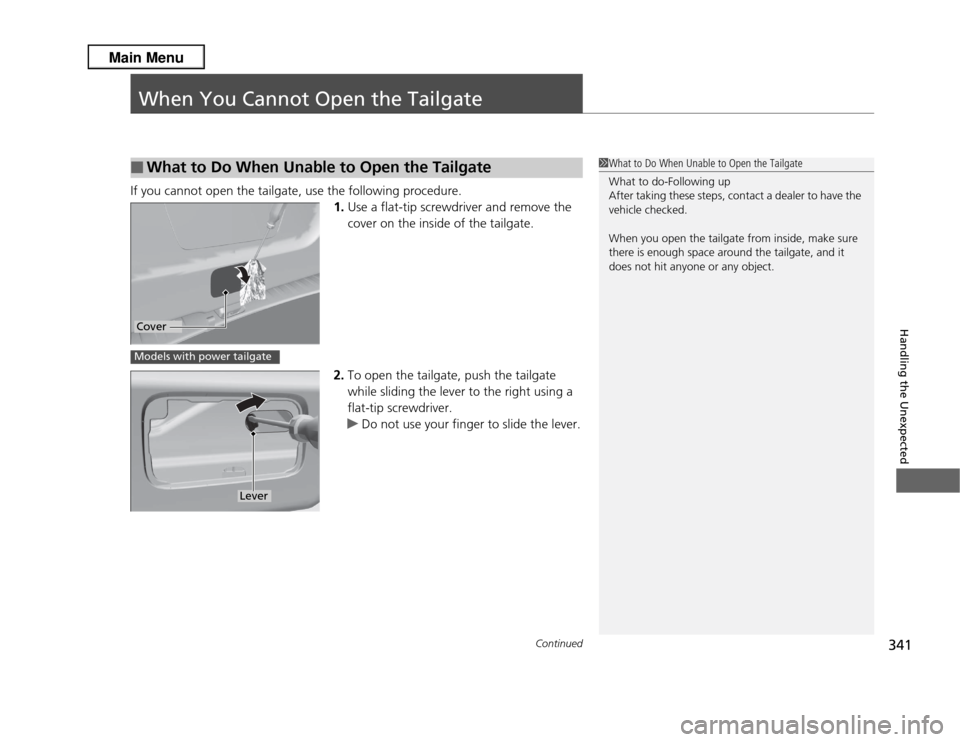
341
Continued
Handling the Unexpected
When You Cannot Open the TailgateIf you cannot open the tailgate, use the following procedure.1.Use a flat-tip screwdriver and remove the
cover on the inside of the tailgate.
2. To open the tailgate, push the tailgate
while sliding the lever to the right using a
flat-tip screwdriver.
u Do not use your finger to slide the lever.■
What to Do When Unable to Open the Tailgate
1What to Do When Unable to Open the Tailgate
What to do-Following up
After taking these steps, contact a dealer to have the
vehicle checked.
When you open the tailgate from inside, make sure
there is enough space around the tailgate, and it
does not hit anyone or any object.
CoverModels with power tailgate
Lever
Page 343 of 364
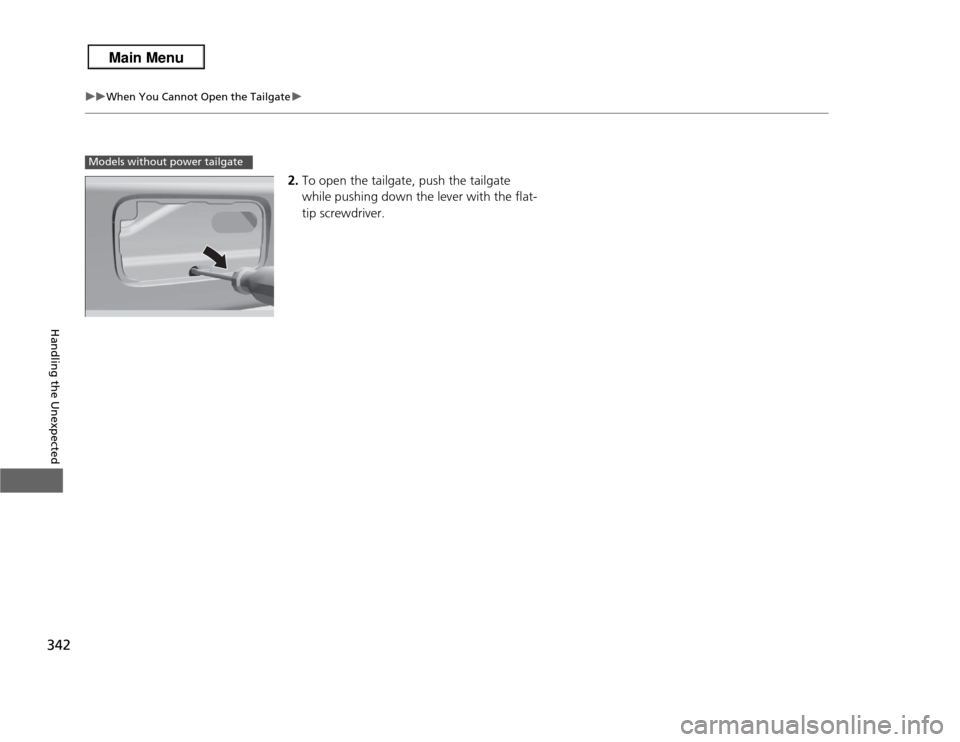
342
uuWhen You Cannot Open the Tailgate u
Handling the Unexpected
2.To open the tailgate, push the tailgate
while pushing down the lever with the flat-
tip screwdriver.
Models without power tailgate
Page 344 of 364
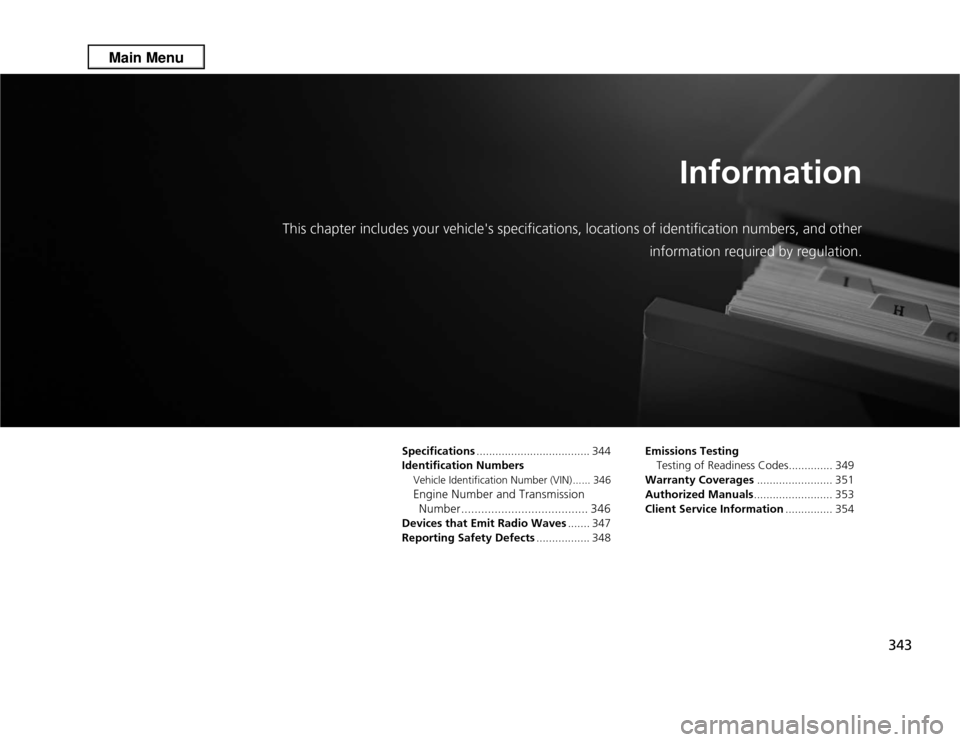
343
Information
This chapter includes your vehicle's specifications, locations of identification numbers, and otherinformation required by regulation.
Specifications.................................... 344
Identification NumbersVehicle Identification Nu mber (VIN) ...... 346Engine Number and Transmission
Number...................................... 346Devices that Emit Radio Waves ....... 347
Reporting Safety Defects ................. 348Emissions Testing
Testing of Readiness Codes.............. 349
Warranty Coverages ........................ 351
Authorized Manuals ......................... 353
Client Service Information ............... 354
Page 345 of 364
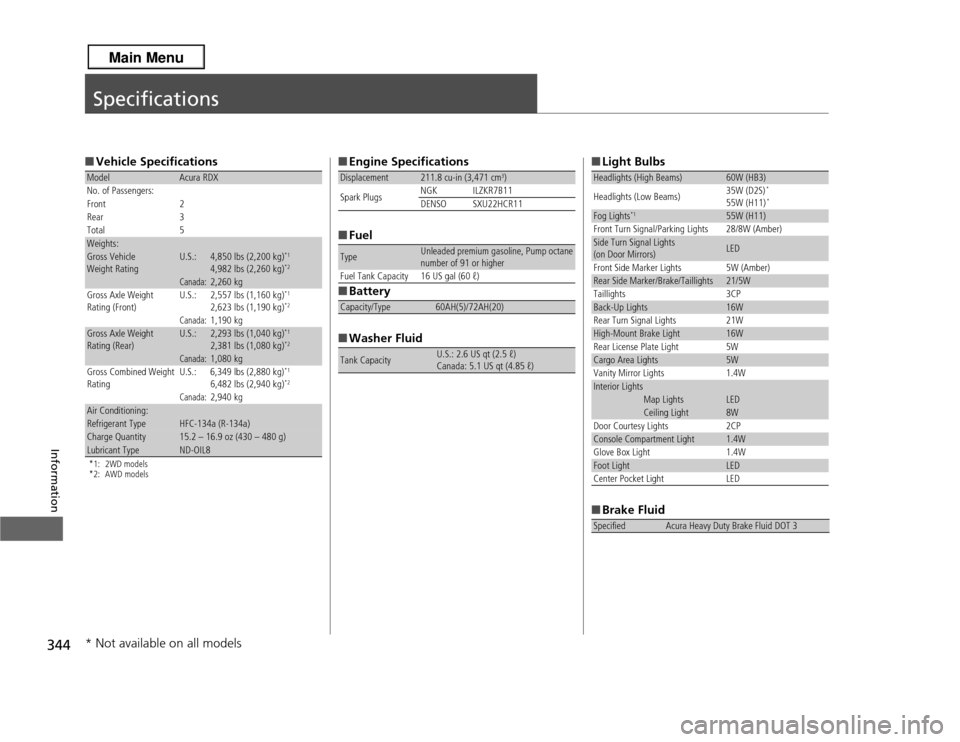
344Information
Specifications■Vehicle Specifications*1: 2WD models
*2: AWD modelsModel
Acura RDX
No. of Passengers:
Front 2
Rear 3
Total 5
Weights:Gross Vehicle
Weight Rating
U.S.:
4,850 lbs (2,200 kg)
*1
4,982 lbs (2,260 kg)
*2
Canada:
2,260 kg
Gross Axle Weight
Rating (Front)
U.S.:
2,557 lbs (1,160 kg)
*1
2,623 lbs (1,190 kg)
*2
Canada:
1,190 kg
Gross Axle Weight
Rating (Rear)
U.S.:
2,293 lbs (1,040 kg)
*1
2,381 lbs (1,080 kg)
*2
Canada:
1,080 kg
Gross Combined Weight
Rating U.S.: 6,349 lbs (2,880 kg)
*1
6,482 lbs (2,940 kg)
*2
Canada:
2,940 kg
Air Conditioning:Refrigerant Type
HFC-134a (R-134a)
Charge Quantity
15.2 – 16.9 oz (430 – 480 g)
Lubricant Type
ND-OIL8
■
Engine Specifications
■ Fuel
■ Battery
■ Washer FluidDisplacement
211.8 cu-in (3,471 cm
3)
Spark Plugs NGK ILZKR7B11
DENSO SXU22HCR11
Type
Unleaded premium gasoline, Pump octane
number of 91 or higher
Fuel Tank Capacity 16 US gal (60 ℓ)
Capacity/Type
60AH(5)/72AH(20)
Tank Capacity
U.S.: 2.6 US qt (2.5 ℓ)
Canada: 5.1 US qt (4.85 ℓ)
■ Light Bulbs
■ Brake FluidHeadlights (High Beams)
60W (HB3)
Headlights (Low Beams) 35W (D2S)
*
55W (H11)
*
Fog Lights
*1
55W (H11)
Front Turn Signal/Parking Lights 28/8W (Amber)
Side Turn Signal Lights
(on Door Mirrors)
LED
Front Side Marker Lights 5W (Amber)
Rear Side Marker/Brake/Taillights
21/5W
Taillights 3CP
Back-Up Lights
16W
Rear Turn Signal Lights 21W
High-Mount Brake Light
16W
Rear License Plate Light 5W
Cargo Area Lights
5W
Vanity Mirror Lights 1.4W
Interior Lights
Map Lights
LED
Ceiling Light
8W
Door Courtesy Lights 2CP
Console Compartment Light
1.4W
Glove Box Light 1.4W
Foot Light
LED
Center Pocket Light LED
Specified
Acura Heavy Duty Brake Fluid DOT 3
* Not available on all models
Page 346 of 364
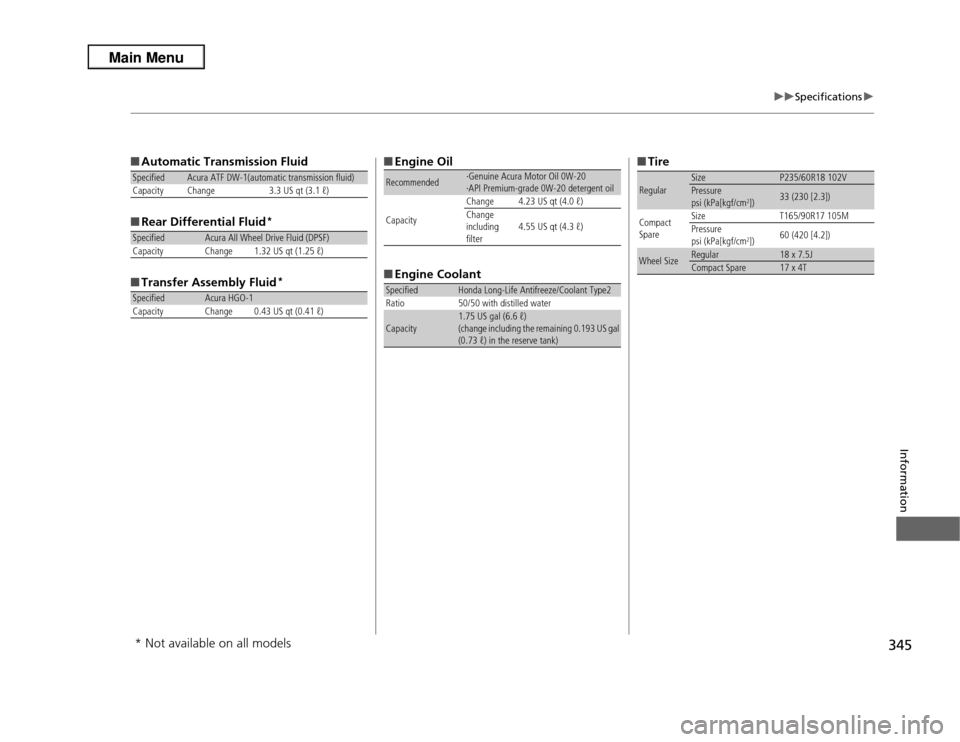
345
uuSpecifications u
Information
■Automatic Transmission Fluid
■ Rear Differential Fluid
*
■Transfer Assembly Fluid
*
Specified
Acura ATF DW-1(automatic transmission fluid)
Capacity Change 3.3 US qt (3.1 ℓ)
Specified
Acura All Wheel Drive Fluid (DPSF)
Capacity Change 1.32 US qt (1.25 ℓ)
Specified
Acura HGO-1
Capacity Change 0.43 US qt (0.41 ℓ)
■ Engine Oil
■ Engine CoolantRecommended
·Genuine Acura Motor Oil 0W-20
·API Premium-grade 0W-20 detergent oil
Capacity Change 4.23 US qt (4.0 ℓ)
Change
including
filter
4.55 US qt (4.3 ℓ)
Specified
Honda Long-Life Antifreeze/Coolant Type2
Ratio 50/50 with distilled water
Capacity
1.75 US gal (6.6 ℓ)
(change including the remaining 0.193 US gal
(0.73 ℓ) in the reserve tank)
■ TireRegular
Size
P235/60R18 102V
Pressure
psi (kPa[kgf/cm
2])
33 (230 [2.3])
Compact
Spare Size
T165/90R17 105M
Pressure
psi (kPa[kgf/cm
2]) 60 (420 [4.2])
Wheel Size
Regular
18 x 7.5J
Compact Spare
17 x 4T
* Not available on all models
Page 347 of 364
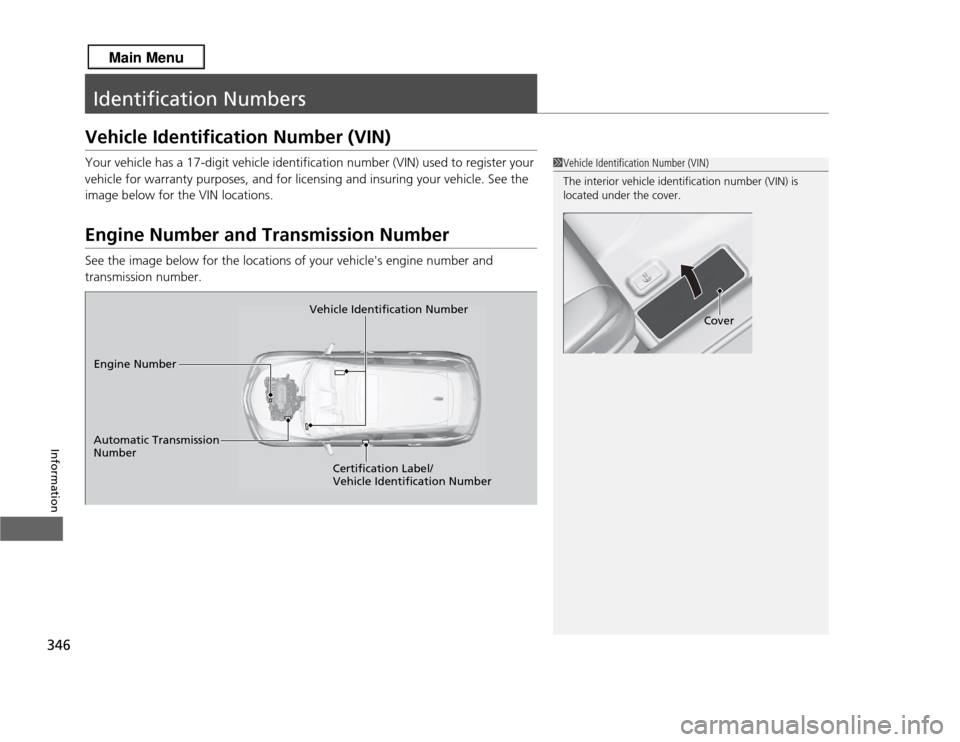
346Information
Identification NumbersVehicle Identification Number (VIN)Your vehicle has a 17-digit vehicle identification number (VIN) used to register your
vehicle for warranty purposes, and for licensing and insuring your vehicle. See the
image below for the VIN locations.Engine Number and Transmission NumberSee the image below for the locations of your vehicle's engine number and
transmission number.
1Vehicle Identification Number (VIN)
The interior vehicle identification number (VIN) is
located under the cover.
Cover
Vehicle Identification Number
Engine Number
Certification Label/
Vehicle Identification Number
Automatic Transmission
Number
Page 348 of 364
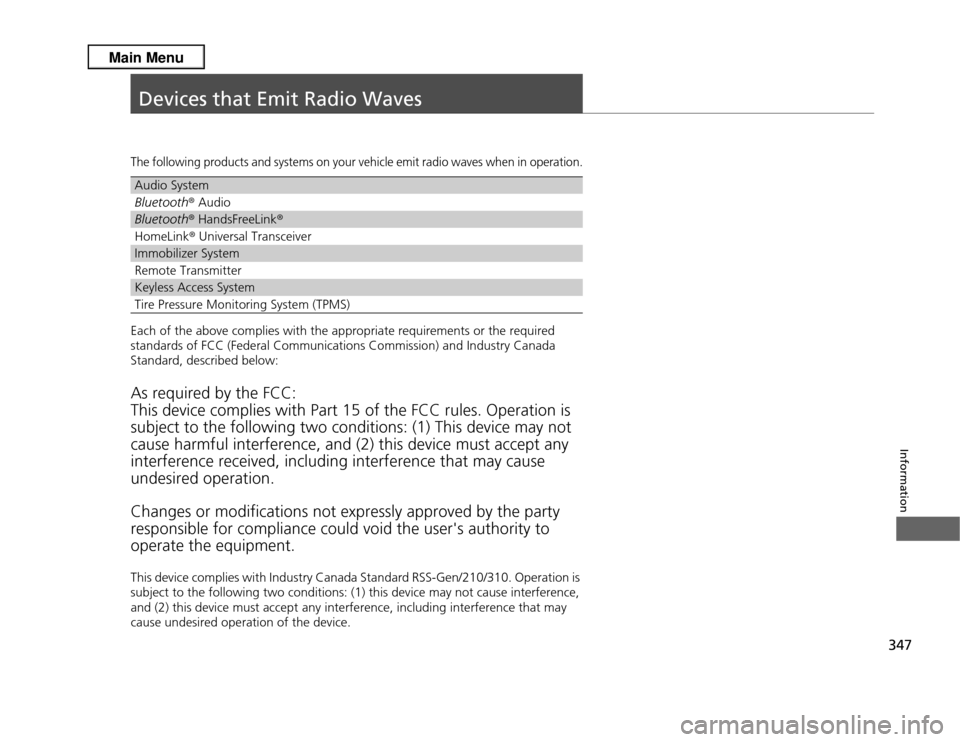
347Information
Devices that Emit Radio WavesThe following products and systems on your vehicle emit radio waves when in operation.Each of the above complies with the appropriate requirements or the required
standards of FCC (Federal Communications Commission) and Industry Canada
Standard, described below:As required by the FCC:
This device complies with Part 15 of the FCC rules. Operation is
subject to the following two conditions: (1) This device may not
cause harmful interference, and (2) this device must accept any
interference received, including interference that may cause
undesired operation.
Changes or modifications not expressly approved by the party
responsible for compliance could void the user's authority to
operate the equipment.This device complies with Industry Canada Standard RSS-Gen/210/310. Operation is
subject to the following two conditions: (1) this device may not cause interference,
and (2) this device must accept any interference, including interference that may
cause undesired operation of the device.Audio SystemBluetooth ® AudioBluetooth ® HandsFreeLink ®HomeLink® Universal TransceiverImmobilizer SystemRemote TransmitterKeyless Access SystemTire Pressure Monitoring System (TPMS)
Page 349 of 364
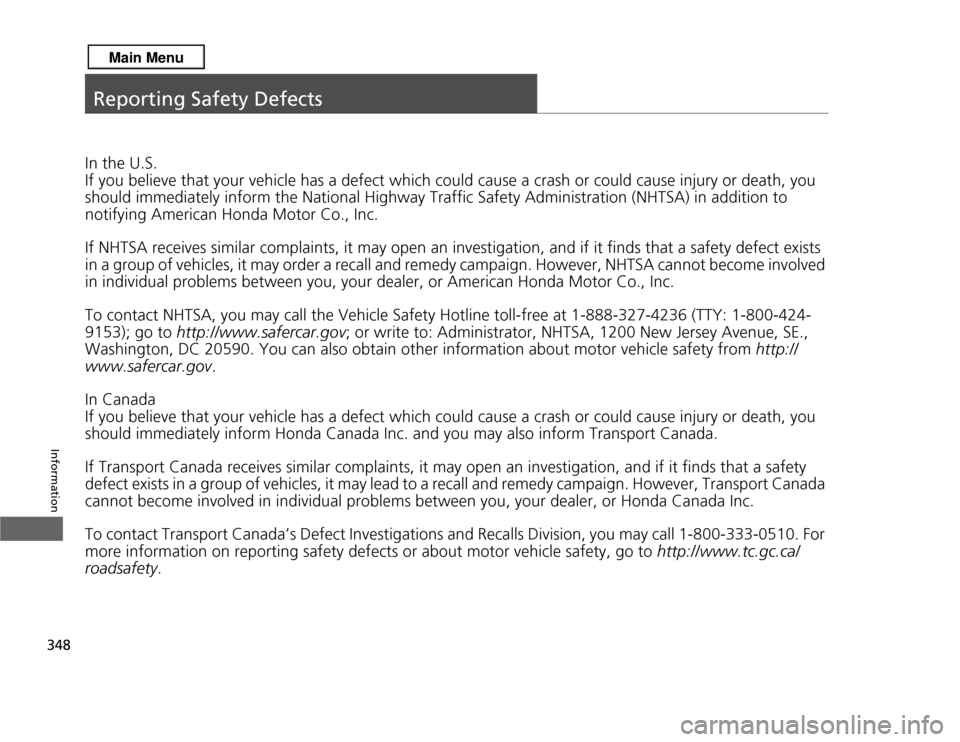
348Information
Reporting Safety DefectsIn the U.S.
If you believe that your vehicle has a defect which could cause a crash or could cause injury or death, you
should immediately inform the National Highway Traffic Safety Administration (NHTSA) in addition to
notifying American Honda Motor Co., Inc.
If NHTSA receives similar complaints, it may open an investigation, and if it finds that a safety defect exists
in a group of vehicles, it may order a recall and remedy campaign. However, NHTSA cannot become involved
in individual problems between you, your dealer, or American Honda Motor Co., Inc.
To contact NHTSA, you may call the Vehicle Safety Hotline toll-free at 1-888-327-4236 (TTY: 1-800-424-
9153); go to http://www.safercar.gov ; or write to: Administrator, NHTSA, 1200 New Jersey Avenue, SE.,
Washington, DC 20590. You can also obtain other informa tion about motor vehicle safety from http://
www.safercar.gov .
In Canada
If you believe that your vehicle has a defect which co uld cause a crash or could cause injury or death, you
should immediately inform Honda Canada Inc. and you may also inform Transport Canada.
If Transport Canada receives similar complaints, it may open an investigation, and if it finds that a safety
defect exists in a group of vehicles, it may le ad to a recall and remedy campaign. However, Transport Canada
cannot become involved in individual problems between you, your dealer, or Honda Canada Inc.
To contact Transport Canada’s Defect Investi gations and Recalls Division, you may call 1-800-333-0510. For
more information on reporting safety defects or about motor vehicle safety, go to http://www.tc.gc.ca/
roadsafety .
Page 350 of 364
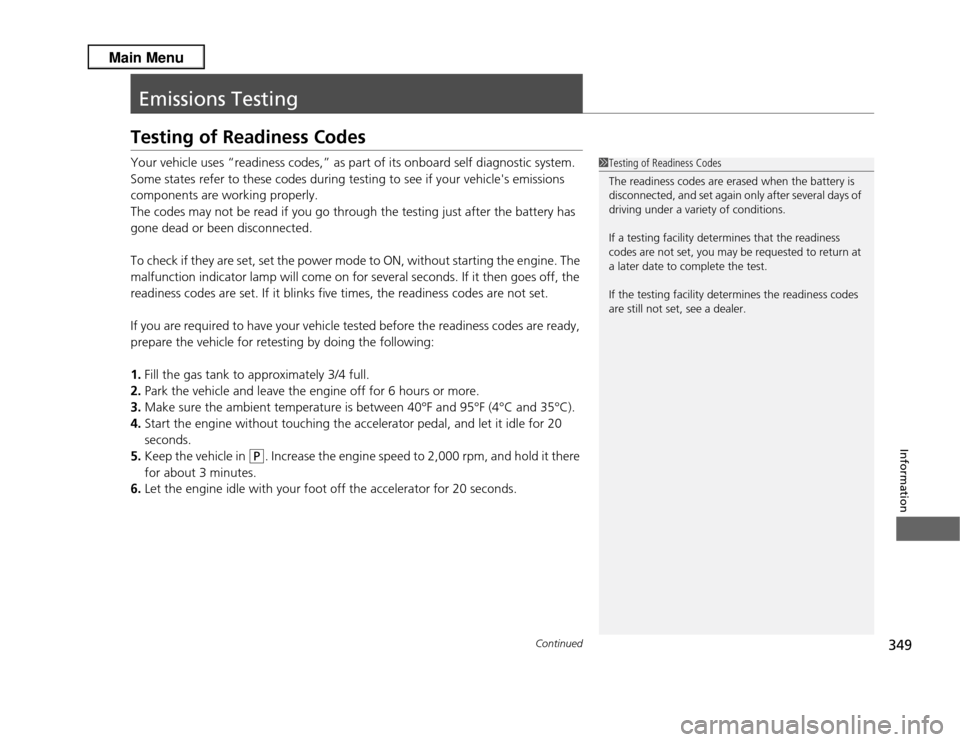
349
Continued
Information
Emissions TestingTesting of Readiness CodesYour vehicle uses “readiness codes,” as part of its onboard self diagnostic system.
Some states refer to these codes during testing to see if your vehicle's emissions
components are working properly.
The codes may not be read if you go through the testing just after the battery has
gone dead or been disconnected.
To check if they are set, set the power mode to ON, without starting the engine. The
malfunction indicator lamp will come on for several seconds. If it then goes off, the
readiness codes are set. If it blinks five times, the readiness codes are not set.
If you are required to have your vehicle tested before the readiness codes are ready,
prepare the vehicle for retesting by doing the following:
1.Fill the gas tank to approximately 3/4 full.
2. Park the vehicle and leave the engine off for 6 hours or more.
3. Make sure the ambient temperature is between 40°F and 95°F (4°C and 35°C).
4. Start the engine without touching the accelerator pedal, and let it idle for 20
seconds.
5. Keep the vehicle in
(P
. Increase the engine speed to 2,000 rpm, and hold it there
for about 3 minutes.
6. Let the engine idle with your foot off the accelerator for 20 seconds.
1Testing of Readiness Codes
The readiness codes are erased when the battery is
disconnected, and set again only after several days of
driving under a variety of conditions.
If a testing facility determines that the readiness
codes are not set, you may be requested to return at
a later date to complete the test.
If the testing facility determines the readiness codes
are still not set, see a dealer.